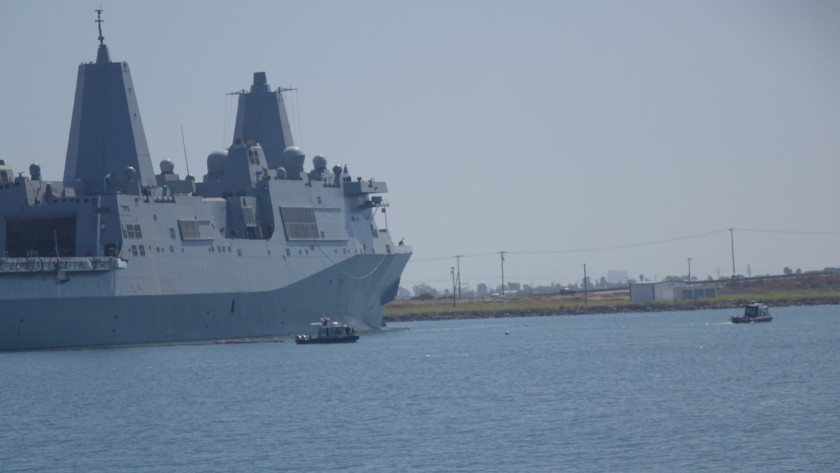Author: DANIEL LANGHORNE
Published: Sep 05, 2019
Seal Beach

A contractor could start dredging Anaheim Bay toward the end of the year, kicking off a $154 million endeavor by the Navy that will allow larger ships to dock at Naval Weapons Station Seal Beach.
The dredging work is one component of a long-awaited, multi-stage modernization project that will replace the World War II-era ammunition pier with one that meets the growing Pacific Fleet’s needs.
By next year, about 60% of U.S. naval forces will be based in the Pacific, up from 40% a decade ago, partly to counterbalance China’s modernizing military.
Seal Beach’s primary missions are to store ordnance for the Navy and Marine Corps, load and unload ammunition and maintain weapons on warships departing San Diego.
Increasing the depth of Anaheim Bay’s turning basin to accommodate the amphibious assault ships that carry Marines, armored vehicles and aircraft, is a priority. These ships currently have to be resupplied at sea by Marine helicopters off Camp Pendleton.
Two guided-missile destroyers will also be able to simultaneously rearm at the new pier. The naval base can currently accommodate only one ship at a time.
Naval Facilities Engineering Command awarded the $117.8 million first phase of the dredging and pier construction contract on July 15 to Manson/Connolly Seal Beach JV. The job is a joint venture between marine construction firms Manson Construction of Seattle and Connolly-Pacific Co. of Long Beach.
To allow vehicles to access the new wharf, the Navy will build a causeway across the east side of the bay and create a new public navigation channel for Huntington Harbour.
The Navy closes Anaheim Bay to public boating traffic while ships are entering or leaving the base. The base closed the harbor to civilian craft for about an hour on Aug. 29 while security boat crews trained by speeding around the docked USS New Orleans and simulated automatic gunfire with blank ammunition.
The construction schedule has not yet been finalized but dredging could begin toward the end of this year or in early 2020, Seal Beach base spokesman Gregg Smith said.
The dredging work, including the creation of the public navigation channel, is estimated to take a year. The entire project is expected to last five to six years, according to a Navy report.
“Construction of the causeway will not be started until completion of the new public boat navigation channel, so there will always be a way for civilian small craft to transit Anaheim Bay,” Smith said. “We are also working with the Coast Guard to make sure that navigation aids are in place when the new channel opens.”
Seal Beach Councilman Joe Kalmick said many of his constituents would have preferred the Navy not bring in larger ships but he also recognizes the realities of living near a military base.
“Our job as a city is to do whatever we can to ask them to be cautious as they can be and follow all of the environmental rules,” Kalmick said.
Some residents are concerned about noise created by dredging and pile-driving, said Kalmick, who’s been assured the latter will only be conducted during regular working hours. Nighttime dredging will not be allowed within 1,000 feet of the nearest residence.
“At that distance, dredging noise is anticipated to be at or below nighttime background noise levels,” he said.
The dredging project is complicated by the presence of protected marine plant and animals species in Anaheim Bay.
According to a Navy report, biologists surveying the bottom of Anaheim Bay recently found 11.7 acres of eelgrass, which is protected habitat under state and federal laws.
In 2010, Anaheim Bay dredging claimed a good amount of eelgrass and the Navy subsequently reached an agreement with the National Marine Fisheries Service and U.S. Army Corps of Engineers to restore the damaged habitat.
With this new project, the Navy expects to remove at least 1.6 acres of eelgrass, but will in turn plant 6.1 new acres.
Valuable shelter to young fish, eelgrass is also eaten by the area’s green sea turtles, which are recognized as threatened under the Endangered Species Act.
“The causeway would block the existing path of green sea turtle’s ability to move between Anaheim Bay, Huntington Harbour, and the Seal Beach National Wildlife Refuge and could cause sea turtles to become disorientated,” the report states.
Once a new public navigation channel is opened, biologists expect the turtles will learn the new route in a relatively short amount of time, according to the Navy report.
